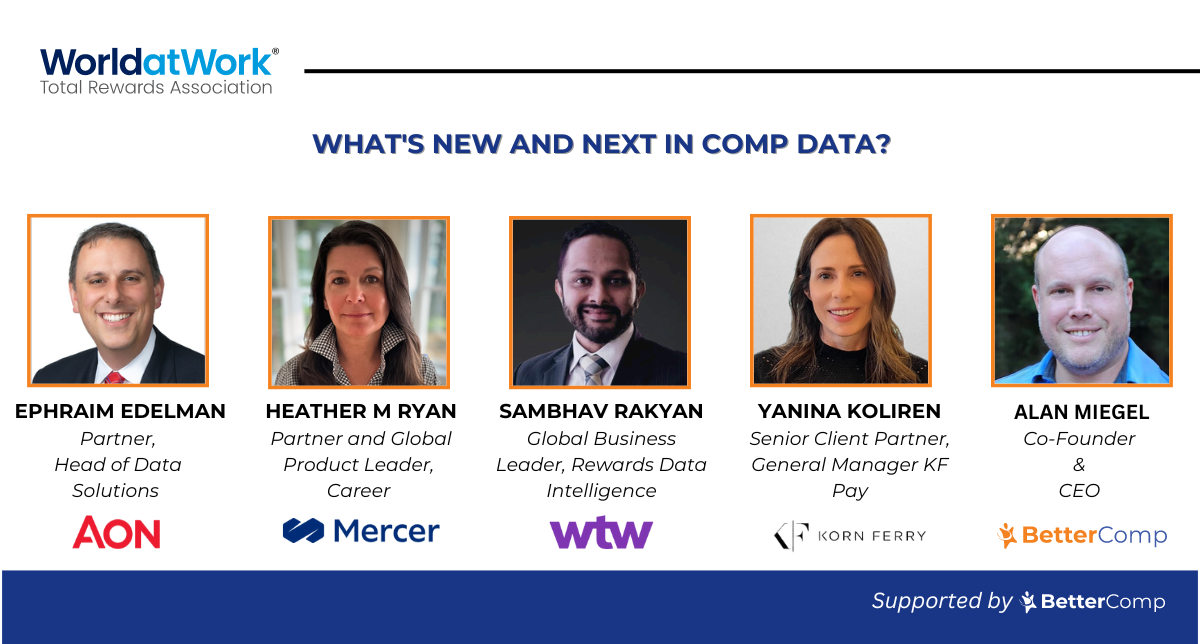Webinar Recap - Navigating Data Diversity: Alternative Data Sources Best Practices
 Alice Kirchhoff
·
5 minute read
Alice Kirchhoff
·
5 minute read
Companies are buying more compensation data—and a greater variety of it—than ever before. Even just five years ago, organizations relied almost exclusively on traditional surveys for concrete data. Since then, technological advancements and shifts in both the regulatory landscape and workplace culture have generated a wave of alternative compensation data sources. As a result, comp pros are increasingly looking to supplement their existing data strategy to gain a more comprehensive perspective.
“Alternative data” is a blanket term used to describe any data source that falls outside of traditional compensation surveys. The swell of available alternative data sources is creating a lot of buzz across the compensation industry. These non-traditional data sources opened up a new world of possibilities for comp pros. However, there are still significant questions (and concerns) about how these sources compare to established methods and how to best integrate them into existing frameworks.
Our panelists Jordan Clark (Meijer), Mark Briggs (WM), Matt Lechner (Five9), and Alan Miegel (BetterComp) added some clarity to this data puzzle by addressing the strengths, limitations, and real-world applications of these data sources.
.png?width=700&height=394&name=August%2022%20Webinar_%20NAVIGATING%20DATA%20DIVERSITY_%20%20Alternative%20Data%20Sources%20Best%20Practices%20(1).png)
Here are some of the key highlights from this discussion:
There is no such thing as a “perfect” data set
During the webinar, our panelists assessed traditional surveys and four alternative data sources—offers, job posting, aggregated, and crowdsourced—across key market pricing dimensions. These dimensions included volume + density, specificity, recency, and defensibility, and are defined in Table 1 below.
.png?width=2400&height=1600&name=Table%201.%20Defining%20Market%20Pricing%20Dimensions%20%20(1).png)
Table 1. Defining Market Pricing Dimensions
*Volume and Density are different but related concepts. You can’t have density without volume, but it is possible to have volume without density. For the purpose of this webinar, we grouped together these two concepts to highlight their complementary nature. “Volume” is purposefully listed first to emphasize the importance of having good volume as the foundation for meaningful density.
Every type of data available has its strengths and weaknesses. Creating and optimizing a data strategy is about balancing those against organizational needs. For example, while traditional surveys excel in volume (and typically density), specificity, and defensibility, they tend to fall short on recency. On the other hand, offers data is very recent but lacks comparatively in volume and density.
Alternative data sources — even within the same category— can vary widely in how they rank across the market pricing dimensions. Just like with surveys, every individual provider has their own unique methodology that affects the final output. Because there is so much variability in the methods used to collect, validate, and process the information, it’s crucial to work with data providers who are transparent about their processes and methodology, so you can fully understand the strengths and limitations of the data you're using.
To see how each data source ranked across these dimensions, download our data evaluation guide.
Alternative data sources offer a unique lens to analyze competitive pay
Our panelists emphasized that while alternative data sources are not a replacement for traditional compensation surveys today, they provide an additional perspective for analyzing competitive pay. Drawing from their real-world experiences, our panelists shared insights into the strengths, weaknesses, and specific use cases of each alternative data source.
Offers Data:
Matt described offers data, which he gets from our friends at Compa, as “one of the most immediate and actionable sources of compensation information available,” often reflecting pay trends within a 1-3 month window. Offers data provides a snapshot of what companies are currently willing to pay for specific roles and locations, while also shedding light on candidate reactions through accepted and declined rates.
Matt explained that the recency of offers data allows his team to adjust quickly and stay competitive. Having insight into a range of offers (high to low) and seeing how candidates respond to those offers also provides valuable information that helps prevent overpayment. Matt finds offers data especially useful when they are hiring rapidly, when the market is fluctuating due to external factors like the economy, and when a new talent competitor moves into the market.
Job Posting Data:
Mark provided valuable insights into how job posting data can be a practical tool for compensation analysis, especially when published surveys haven’t caught up with new or rapidly evolving roles. He explained how it can help validate pay levels for emerging positions, address manager concerns about hiring within budget, and even refine company job descriptions by benchmarking against other organizations. Mark noted that job posting is also a great tool for those wanting to view trends more specifically since it allows you to drill down to specific months and/or geography.
However, Mark stressed the importance of approaching job posting data with caution due to potential biases and inconsistencies. This includes variations in job titles, the lack of data for low-turnover roles, and differences in how salary information is reported across companies, locations and industries (eg. base pay vs. variable pay).
Aggregated Data:
Aggregated data gathers different compensation information from various sources and uses mathematical analysis to provide a more consolidated view. Towards the end of the pandemic, retail chains faced a tight labor market and needed more regional and local data than national surveys could provide.
Jordan and his team at Meijer—a supermarket chain with 248 locations across six states— were in need of more localized insights to validate their data strategy. They chose not to use job posting data for this purpose because most states they operate in don't mandate pay transparency, resulting in highly inconsistent job posting information. Instead, Jordan’s team landed on an aggregation tool that allowed them to drill down to certain zip codes for specific jobs. Having access to these local data points was critical for gaining leadership buy-in for their compensation strategy. The consolidated nature of aggregated data makes it great for getting extensive coverage. However, Jordan noted that it is challenging to assess the recency and specificity because you often have no insight into the specific data points being used in the calculation.
Crowdsourced Data:
Alan clarified the role of crowdsourced data, which typically comes as employee reported information on public forums like Glassdoor. Since most crowdsourced data is not validated or verified, it's very difficult to be confident about its quality and accuracy. While crowdsourced data is very cost-effective and can offer insights into what employees are seeing, it is not ideal as a primary benchmarking tool because it often greatly lacks defensibility. Levels.fyi stands out as one of the few crowdsourced data providers that validates the information, adding a layer of credibility.
Best practices for leveraging alternative data
Our panelists also shared best practices to help integrate alternative data effectively. Here are some of the major insights:
-
Align Data Sources with Business Needs
Jordan emphasized the importance of "really understanding that business need that some of these data sources would fulfill." As shown by the real-world examples above, different alternative data sources serve different use cases. Therefore, identifying the problem you're trying to solve is a critical step in aligning the right data with your specific business needs and maximizing its value.
-
Strengthen and Understand Job Architecture
Mark stressed the role of job architecture in leveraging alternative data sources, noting that "the energy that you put into your company's job architecture will greatly enhance your ability to incorporate alternative data sources into your competitive pay analytics." He advised spending ample time understanding your job roles and how they relate to each other.
-
Assess Data Relevance and Methodologies
Matt highlighted the importance of evaluating data relevance, noting "There is data literally everywhere now…But it's not all relevant to use." When choosing a data set, Matt encourages comp pros to consider “Does it have the right set of companies? Does it have the right pay elements?” He also emphasized the importance of understanding the methodology behind the data and working with data providers that can ensure the data is well-cleaned, validated, and applicable to your organization.
Want to watch the full discussion? Register here to access the on-demand recording or in your WorldatWork profile if you previously registered!
To see how each data source ranked across different market pricing dimensions, download our data evaluation guide.


